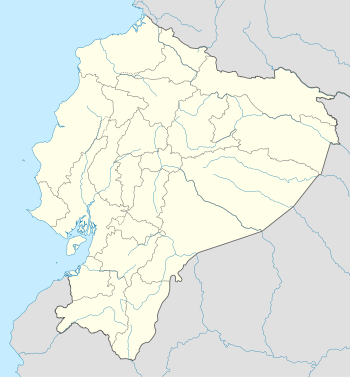Eloy Alfaro International Airport
| Eloy Alfaro International Airport | |||||||||||
|---|---|---|---|---|---|---|---|---|---|---|---|
| IATA: MEC – ICAO: SEMT | |||||||||||
| Summary | |||||||||||
| Airport type | Public / Military | ||||||||||
| Operator | Military of Ecuador | ||||||||||
| Location | Manta, Ecuador | ||||||||||
| Elevation AMSL | 48 ft / 15 m | ||||||||||
| Coordinates | 00°56′45″S 080°40′43″W / 0.94583°S 80.67861°W | ||||||||||
| Map | |||||||||||
 MEC Location of airport in Ecuador | |||||||||||
| Runways | |||||||||||
| |||||||||||
Eloy Alfaro International Airport (IATA: MEC, ICAO: SEMT) is a combination civilian airport and military air base on the outskirts of Manta in the province of Manabí in western continental Ecuador. The airport, also known as Eloy Alfaro Air Base,[3] is named in honor of Eloy Alfaro, a former president of Ecuador. It was inaugurated by the Ecuadorian Air Force on October 24, 1978. It is the fourth busiest airport in Ecuador.
Facilities
The airport resides at an elevation of 48 feet (15 m) above mean sea level. It has one runway designated 05/23 with an asphalt surface measuring 9,383 by 148 feet (2,860 m × 45 m).[1]
Terminals, airlines and destinations
| Airlines | Destinations |
|---|---|
| Avianca Ecuador | Quito |
| Avior Airlines | Barcelona, Anzoátegui |
| TAME | Quito |
Former U.S. military presence
Until July 2009 a portion of the airport was used by the Air Forces Southern Air Force component of the United States Southern Command for operations against illegal cocaine trafficking in northwestern South America. It was formally known as Forward Operating Location Manta. In 1999, the U.S. signed a ten-year agreement with then Ecuadorean President Jamil Mahuad allowing the U.S. to station up 475 military personnel at Manta, rent-free.[4] USAF AWACS E-3 and United States Navy P-3 Orion aircraft, supported by about 300 US military personnel, operated from the base to monitor air traffic in the area. The U.S. aircraft based at Manta fed surveillance information to the Joint Interagency Task Force South in Key West. The aircraft at the base flew about 100 missions a month looking for drug-running boats departing Colombia. In 2007, the flights led to about 200 cocaine seizures, totaling about 230 tons. The flights accounted for about 60 percent of U.S. drug interdiction in the eastern Pacific.[5][6][7]
Since prior to his election, President Rafael Correa has stated that he would not renew the agreement that allowed the United States access to the base when it expires in November 2009, and commented that "We can negotiate with the U.S. about a base in Manta, if they let us put a military base in Miami..." .[8] On March 19, 2008 the Ecuadorian Constituent Assembly voted to outlaw the installation of any foreign military bases in Ecuador.[9] On July 26, 2008 Ecuador's Foreign Ministry formally notified the U.S. embassy that the U.S. lease on the base would not be renewed.[7][10]
Admiral James Stavridis, chief of the U.S. Southern Command stated on April 21, 2008 that there were no plans to find a replacement drug-interdiction air base in South America if Ecuador declined to renew the lease of Manta. Instead, the U.S. military would use existing air bases in El Salvador, Curaçao, and Key West, Florida for drug-surveillance flights.[11] Other bases in the continental mass have been posited as candidates for a replacement. The most credible claim of a country prone to host such a base is probably Colombia, whose base in Puerto Salgar recently entered a process of recertification by the US military.[12]
On April 14, 2009 U.S. ambassador to Colombia William Brownfield announced that the base would be relocating from Manta to a location somewhere in Colombia. Said Brownfield, "Colombia and the U.S. are collaborating on efforts against illegal drugs. Part of this collaboration, without doubt, requires access to facilities between both countries."[13] As of July 2009, the US was negotiating with Colombia to use Palanquero Air Base in Puerto Salgar as Manta's replacement.[14]
The last U.S. military anti-narcotics surveillance mission from Manta was flown on July 17, 2009.[15]
See also
References
- 1 2 Airport information for SEMT from DAFIF (effective October 2006)
- ↑ Airport information for MEC at Great Circle Mapper. Source: DAFIF (effective October 2006).
- ↑ Eloy Alfaro Air Base, Manta, Ecuador from GlobalSecurity.org
- ↑ Anti-drug air base pact to be ended from the Washington Times website
- ↑ Butler, Amy, "Down South: Regional cost-sharing seems an option for Central American AFs’ aging systems", Aviation Week & Space Technology, January 21, 2008, p. 34
- ↑ Romero, Simon, "Ecuador Opposes Outpost In American War On Drugs", New York Times, May 12, 2008, Pg. 8
- 1 2 Washington Times, "U.S. Told To Stop Using Air Base", July 30, 2008, Pg. 19; Partlow, Joshua, "Ecuador Giving U.S. Air Base The Boot", Washington Post, September 4, 2008.
- ↑ http://www.washingtontimes.com/article/20071023/FOREIGN01/110230068/1003
- ↑ U.S. military base contract in Ecuador not to be renewed after 2009 from xinhuanet.com
- ↑ Base gone by late 2009
- ↑ Washington Post, April 22, 2008, p. 12
- ↑ U.S. Military Looks to Colombia to Replace Base in Ecuador from venezuelanalysis.com, a Caracas-based website providing "information and analysis on Venezuela in the English language"
- ↑ Morrison, James, "Embassy Row: Moving to Columbia", Washington Times, April 15, 2009, p. 12.
- ↑ Bajak, Frank, (Associated Press), "U.S., Colombia said to be near base access deal", Military Times, July 15, 2009.
- ↑ Solano, Gonzalo (Associated Press), "US Anti-Drug Force Flies Last Flight From Ecuador", Miami Herald, July 17, 2009.
External links
- "Aviación - Ala 23 "Eloy Alfaro" - Manta" (in Spanish). Archived from the original on 2006-05-01.
- Current weather for SEMT at NOAA/NWS
- Accident history for MEC at Aviation Safety Network